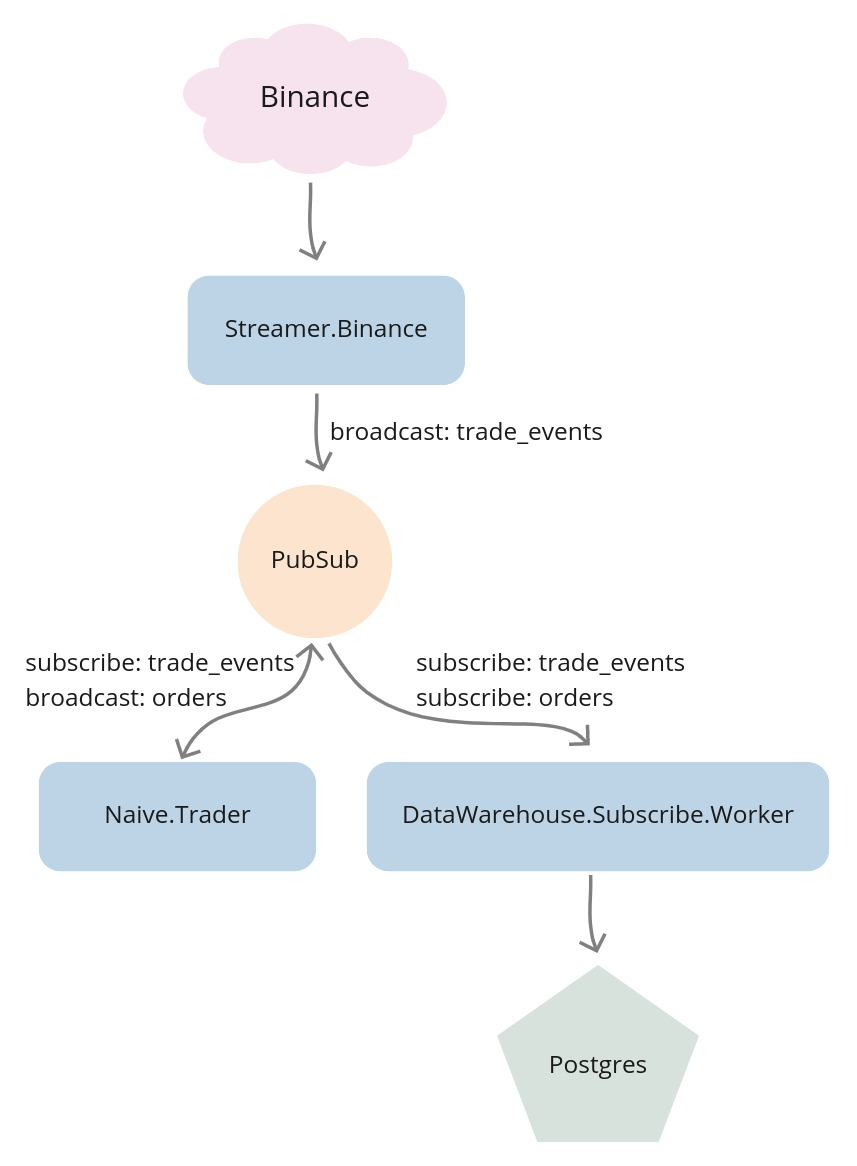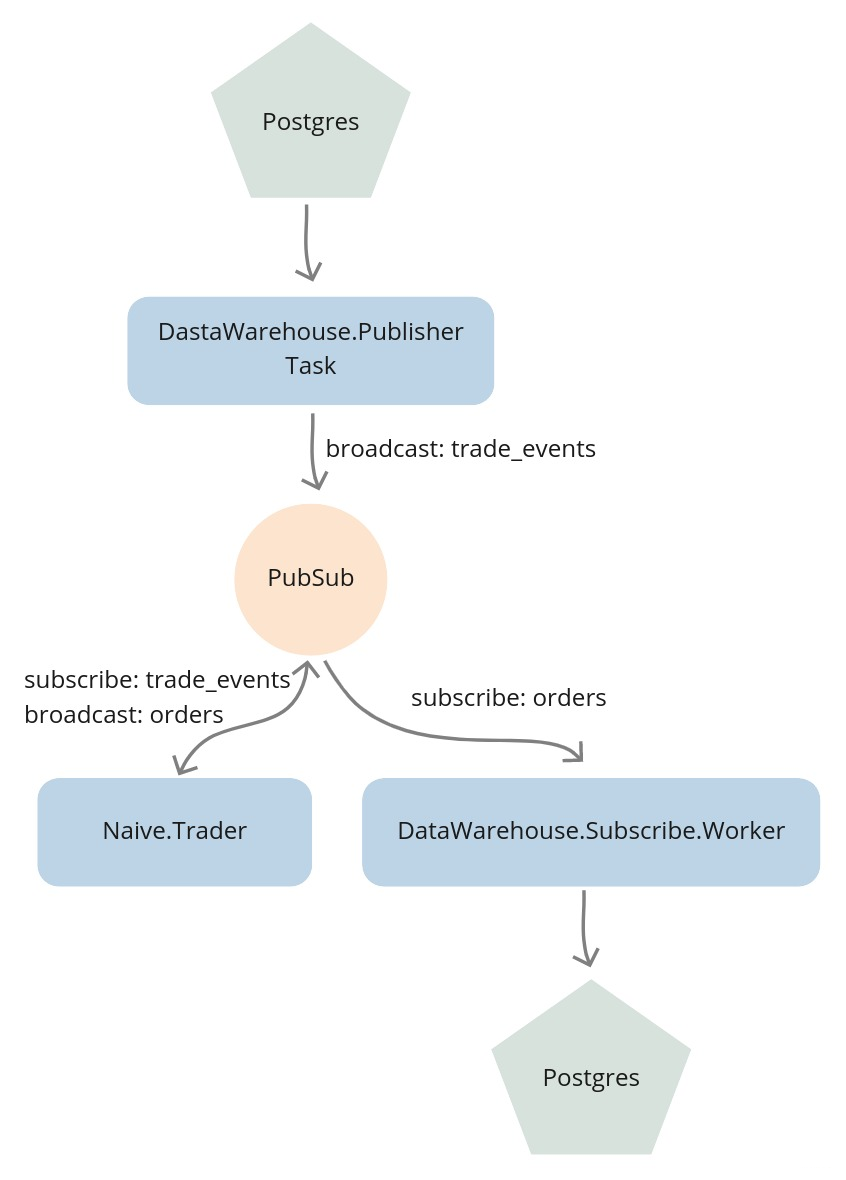Chapter 15 Backtest trading strategy
15.2 Overview of requirements
In the last chapter, we started storing trade events and orders in the database which will be crucial for backtesting, which we will focus on in this chapter.
Backtesting is a procedure of running historical data through the system and observing how our strategy would perform as if we would run it “in the past”. Backtesting works on assumption that the market will behave in a similar fashion in the future as it was in the past.
At this moment we are receiving the trade events from the Binance through WebSocket. The Streamer.Binance process is handling those messages by parsing them from JSON string to map, then converting them to structs and broadcasting them to the TRADE_EVENTS:#{symbol} PubSub topic. The Naive.Trader subscribes to the TRADE_EVENTS:#{symbol} topic and takes decisions based on incoming data. As it places buy and sell orders it broadcasts them to the ORDERS:#{symbol} PubSub topic. The DataWarehouse.Subscriber.Worker processes subscribe to both trade events and orders topics and store incoming data inside the database.
We can visualize this flow like that:

To backtest we can substitute the Streamer.Binance process with a Task that will stream trade events’ data from the database and broadcasts it to the TRADE_EVENTS:#{symbol} PubSub topic(the same topic as the Streamer.Binance process).
From the perspective of the Naive.Trader it does not make any difference who is broadcasting those trade events. This should be a clear indication of the value of publish/subscribe model that we implemented from the beginning. It allows us to swap producer and consumers freely to backtest our trading strategies:

15.3 Implement the storing task
We will start by creating a new file called publisher.ex inside the
apps/data_warehouse/lib/data_warehouse directory. We will start by implementing the basic Task behavior:
# /apps/data_warehouse/lib/data_warehouse/publisher.ex
defmodule DataWarehouse.Publisher do
use Task
def start_link(arg) do
Task.start_link(__MODULE__, :run, [arg])
end
def run(arg) do
# ...
end
endTo be able to query the database we will import Ecto and require Logger for logging:
# /apps/data_warehouse/lib/data_warehouse/publisher.ex
...
import Ecto.Query, only: [from: 2]
require Logger
...We can now modify the run/1 function to expect specific type, symbol, from, to and interval:
# /apps/data_warehouse/lib/data_warehouse/publisher.ex
...
def run(%{
type: :trade_events,
symbol: symbol,
from: from,
to: to,
interval: interval
}) do
... Inside the body of the run/1 function, first, we will convert from and to Unix timestamps by using private helper functions as well as make sure that the passed symbol is uppercase:
# /apps/data_warehouse/lib/data_warehouse/publisher.ex
...
def run(%{
...
}) do
symbol = String.upcase(symbol)
from_ts =
"#{from}T00:00:00.000Z"
|> convert_to_ms()
to_ts =
"#{to}T23:59:59.000Z"
|> convert_to_ms()
end
...
defp convert_to_ms(iso8601DateString) do
iso8601DateString
|> NaiveDateTime.from_iso8601!()
|> DateTime.from_naive!("Etc/UTC")
|> DateTime.to_unix()
|> Kernel.*(1000)
endNext, we will select data from the database but because of possibly hundreds of thousands of rows being selected and because we are broadcasting them to the PubSub every x ms it could take a substantial amount of time to broadcast all of them. Instead of selecting data and storing all of it in the memory, we will use Repo.stream/1 function to keep broadcasting it on the go. Additionally, we will add index to the data to be able to log info messages every 10k messages. The last thing that we need to define will be the timeout value - the default value is 5 seconds and we will change it to :infinity:
# /apps/data_warehouse/lib/data_warehouse/publisher.ex
def run(%{
...
}) do
...
DataWarehouse.Repo.transaction(
fn ->
from(te in DataWarehouse.Schema.TradeEvent,
where:
te.symbol == ^symbol and
te.trade_time >= ^from_ts and
te.trade_time < ^to_ts,
order_by: te.trade_time
)
|> DataWarehouse.Repo.stream()
|> Enum.with_index()
|> Enum.map(fn {row, index} ->
:timer.sleep(interval)
if rem(index, 10_000) == 0 do
Logger.info("Publisher broadcasted #{index} events")
end
publish_trade_event(row)
end)
end,
timeout: :infinity
)
Logger.info("Publisher finished streaming trade events")
endFinally, the above code uses the publish_trade_event/1 helper function which converts DataWarehouse’s TradeEvent to the Streamer’s TradeEvent to broadcast the same structs as the streamer application:
# /apps/data_warehouse/lib/data_warehouse/publisher.ex
...
defp publish_trade_event(%DataWarehouse.Schema.TradeEvent{} = trade_event) do
new_trade_event =
struct(
Streamer.Binance.TradeEvent,
trade_event |> Map.to_list()
)
Phoenix.PubSub.broadcast(
Streamer.PubSub,
"TRADE_EVENTS:#{trade_event.symbol}",
new_trade_event
)
endWe also need to remember about keeping the interface tidy so we will add publish_data to the DataWarehouse module:
# /apps/data_warehouse/lib/data_warehouse.ex
...
def publish_data(args) do
DataWarehouse.Publisher.start_link(args)
end
...This finishes our implementation - we should be able to stream trade events from the database to the PubSub using the above Task which we will do below.
15.4 Test the backtesting
For consistency and ease of testing/use, I prepared an compressed single data of trade events for XRPUSDT(2019-06-03). We can download that file from GitHub using wget:
$ cd /tmp
$ wget https://github.com/Cinderella-Man/binance-trade-events \
/raw/master/XRPUSDT/XRPUSDT-2019-06-03.csv.gzWe can now uncompress the archive and load those trade events into our database:
$ gunzip XRPUSDT-2019-06-03.csv.gz
$ PGPASSWORD=hedgehogSecretPassword psql -Upostgres -h localhost -ddata_warehouse \
-c "\COPY trade_events FROM '/tmp/XRPUSDT-2019-06-03.csv' WITH (FORMAT csv, delimiter ';');"
COPY 206115The number after the word COPY in the response indicates the number of rows that got copied into the database.
We can now give it a try and run full backtesting but first let’s clean the orders table:
$ psql -Upostgres -h127.0.0.1
Password for user postgres:
...
postgres=# \c data_warehouse
You are now connected to database "data_warehouse" as user "postgres".
data_warehouse=# DELETE FROM orders;
DELETE ...We can now start a new iex session where we will start trading(the naive application) as well as storing orders(the data_warehouse application) and instead of starting the Streamer.Binance worker we will start the DataWarehouse.Publisher task with arguments matching the imported day and symbol:
$ iex -S mix
...
iex(1)> DataWarehouse.start_storing("ORDERS", "XRPUSDT")
19:17:59.596 [info] Starting storing data from ORDERS:XRPUSDT topic
19:17:59.632 [info] DataWarehouse worker is subscribing to ORDERS:XRPUSDT
{:ok, #PID<0.417.0>}
iex(2)> Naive.start_trading("XRPUSDT")
19:18:16.293 [info] Starting Elixir.Naive.SymbolSupervisor worker for XRPUSDT
19:18:16.332 [info] Starting new supervision tree to trade on XRPUSDT
{:ok, #PID<0.419.0>}
19:18:18.327 [info] Initializing new trader(1615288698325) for XRPUSDT
iex(3)> DataWarehouse.publish_data(%{
type: :trade_events,
symbol: "XRPUSDT",
from: "2019-06-02",
to: "2019-06-04",
interval: 5
})
{:ok, #PID<0.428.0>}
19:19:07.532 [info] Publisher broadcasted 0 events
19:19:07.534 [info] The trader(1615288698325) is placing a BUY order for
XRPUSDT @ 0.44391, quantity: 450.5
19:19:07.749 [info] The trader(1615288698325) is placing a SELL order for
XRPUSDT @ 0.44426, quantity: 450.5.
...
19:20:07.568 [info] Publisher broadcasted 10000 events
...
19:21:07.571 [info] Publisher broadcasted 20000 events
19:22:07.576 [info] Publisher broadcasted 30000 events
...
19:39:07.875 [info] Publisher broadcasted 200000 events
19:39:44.576 [info] Publisher finished streaming trade eventsFrom the above log, we can see that it took about 20 minutes to run 206k records through the system(a lot of that time[17+ minutes] was indeed the 5ms sleep).
After the streaming finished we can check out the orders table inside the database to figure out how many trades we made and what income have they generated.
$ psql -Upostgres -h127.0.0.1
Password for user postgres:
...
postgres=# \c data_warehouse
You are now connected to database "data_warehouse" as user "postgres".
data_warehouse=# SELECT COUNT(*) FROM orders;
count
-------
224
(1 row)By looking at the orders we can figure out some performance metrics but that’s less than perfect to get answers to simple questions like “what’s the performance of my strategy?”. We will address that and other concerns in future chapters.
[Note] Please remember to run the mix format to keep things nice and tidy.
The source code for this chapter can be found on GitHub